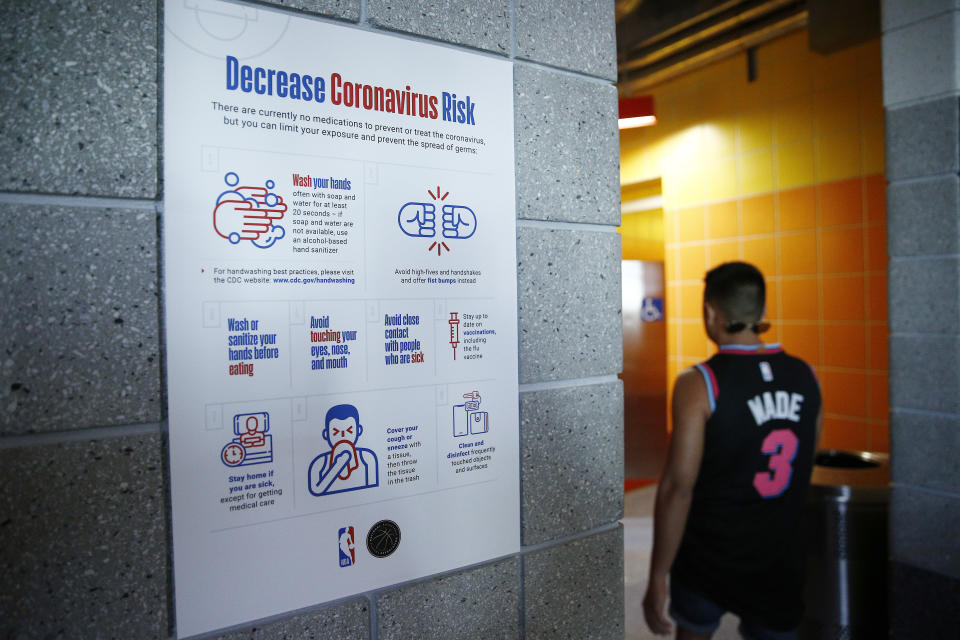How the coronavirus outbreak could impact the NBA's salary cap for the 2020-21 season
The financial impact of the indefinite suspension of games is less concerning than the COVID-19 health scare that is enveloping the NBA, but it is one owners and players will deal with eventually.
Teams will lose an estimated $1.9 million in revenue per home game lost, according to calculations separately sourced by Yahoo Sports contributor Keith Smith, Forbes and The Athletic. The loss of games through the end of the month could cost the league roughly $275 million, to say nothing of other Basketball-Related Income (BRI) that may be compromised. That number would climb closer to $500 million if the regular season is lost, significantly more if this hiatus bleeds into the playoffs.
And that could alter a 2020-21 salary cap already lessened by this season’s China controversy.
While the coronavirus could be contained to this spring, the financial losses will still carry forward into next season. That figure will be determined during the league’s eventual moratorium based in large part on this season’s final BRI figures. BRI is split 50-50 between players and owners. Halve the $275 million-500 million, spread it across 30 teams, and the salary cap could fall anywhere from $4.6 million to $8.3 million.
That figure is far from set in stone. The collective bargaining agreement between the NBA and its players’ union has built-in allowances, including a 6 percent cushion for salary overages. The league’s most recent figures — adjusted last month in the wake of the China controversy — project the salary cap to increase from $109.14 million this season to $115 million in 2020-21.

Owners and players may also have to negotiate the path forward. The former could concede that COVID-19 or a similar scare is unlikely to impact next season and account for that in the projection, but the CBA stipulates the league can base next season’s cap on this season’s BRI figures if the two sides fail to reach an agreement. Assuming next season is played in full, the 2021-22 cap will return closer to the current projection of $125 million — a potential spike not unlike the 2016 one that led to Kevin Durant joining the Golden State Warriors and failed to serve a majority of players. If pressed, the NBPA would be wise to smooth any major increases over the next two seasons.
At the very least, the two sides would likely avoid a dip in the salary cap from this season to next, should the final BRI figures signal a slide more significant than $6 million. This is how owners and players handled the 2011 NBA lockout, which cost the league 16 regular-season games per team.
“They agreed on an amount to use for the cap and luxury tax for that season, and used that amount as a minimum for the following season’s cap — it could get higher, but it couldn’t get lower,” Larry Coon, author of the CBA FAQ, told Yahoo Sports. “I suspect they’ll do something similar this year.”
A sizable decrease in next season’s salary cap would have a marked impact on the max contract extensions signed by Ben Simmons, Jamal Murray and Pascal Siakam this past summer. A $6 million decrease in the salary cap next season would cost Simmons and Murray $10 million each.
A decrease would also correspond to a lower veteran minimum, rookie-scale contract, mid-level exception and any more max deals signed this coming summer, all tied to percentages of the cap. If could have significant ramifications for teams planning for 2020 free agency and future flexibility.
This is all insignificant compared to the current global health scare, which includes Utah Jazz teammates Rudy Gobert and Donovan Mitchell among thousands who have contracted COVID-19.
– – – – – – –
Ben Rohrbach is a staff writer for Yahoo Sports. Have a tip? Email him at rohrbach_ben@yahoo.com or follow him on Twitter! Follow @brohrbach
More from Yahoo Sports:

 Yahoo Finance
Yahoo Finance 
